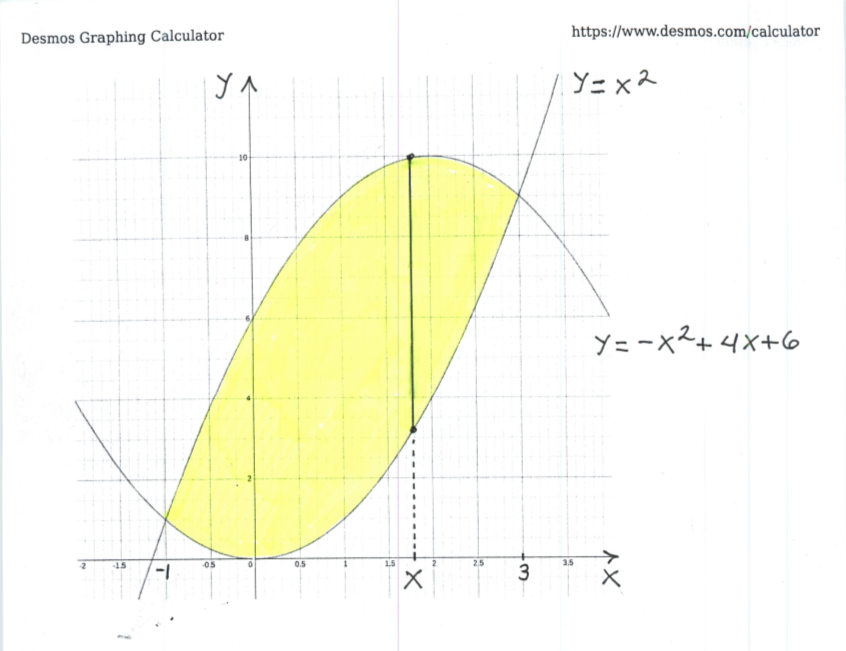SOLUTION 4: Compute the area of the
region enclosed by the graphs of the equations $ y=x^2 $ and $
y=-x^{2}+4x+6 $ . Begin by finding the points of intersection of
the two graphs. From $ y=x^2 $ and $ y=-x^{2}+4x+6 $ we get that
$$ x^{2} = -x^{2} + 4x + 6 \ \ \longrightarrow $$
$$ 2x^{2} - 4x - 6 = 0 \ \ \longrightarrow $$
$$ x^{2} - 2x - 3 = 0 \ \ \longrightarrow $$
$$ (x-3)(x+1) = 0 \ \ \longrightarrow
\ \ x = 3 \ or \ x = -1 $$
Now see the given graph of the enclosed region.

Using vertical cross-sections to describe this region, we get that
$$ -1 \le x \le 3 \ and \ x^2 \le y \le -x^{2}+4x+6 ,$$
so that the area of this region is
$$ AREA = \displaystyle{ \int_{-1}^{3} (Top \ - \ Bottom) \ dx } $$
$$ = \displaystyle { \int_{-1}^{3} ((-x^{2}+4x+6)-(x^{2})) \ dx } $$
$$ = \displaystyle { \int_{-1}^{3} (-2x^{2}+4x+6) \ dx } $$
$$ = \displaystyle { \Big(\frac{-2x^{3}}{3} + \frac{4x^{2}}{2} + 6x
\Big) \Big\vert_{-1}^{3} } $$
$$ = \displaystyle { \Big(-\frac{2}{3}x^{3} + 2x^{2} + 6x \Big)
\Big\vert_{-1}^{3} } $$
$$ = \displaystyle { \Big( -\frac{2}{3}(3)^{3} + 2(3)^{2} + 6(3)
\Big) - \Big( -\frac{2}{3}(-1)^{3} + 2(-1)^{2} + 6(-1) \Big) } $$
$$ = \displaystyle { \Big( -18 + 18 + 18 \Big) - \Big( \frac{2}{3}
+ 2 - 6 \Big) } $$
$$ = \displaystyle { \Big( 18 \Big) - \Big( \frac{2}{3} +
\frac{6}{3} - \frac{18}{3} \Big) } $$
$$ = \displaystyle { \Big( 18 \Big) - \Big( - \frac{10}{3} \Big) } $$
$$ = \displaystyle { \frac{54}{3} + \frac{10}{3} } $$
$$ = \displaystyle {\frac{64}{3}} $$
Click HERE to return to the list of problems.

